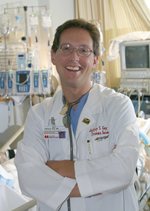
Jeffrey Guy, M.D.
Feds tap into Vanderbilt’s burn expertise

Lillian Nanney, Ph.D.
Vanderbilt Medical Center is one of three clinical sites testing novel products to replace burned skin as part of a new federal grant program.
The Armed Forces Institute of Regenerative Medicine (AFIRM) consists of two academic groups, or consortiums, working with the U.S. Army Institute of Surgical Research to use the science of regenerative medicine to develop new treatments for wounded soldiers.
Regenerative medicine is science that takes advantage of the body's natural healing powers to restore or replace damaged tissue and organs.
One consortium is co-led by the Wake Forest Institute for Regenerative Medicine and the McGowan Institute for Regenerative Medicine, and the other by Rutgers and the Cleveland Clinic. Each consortium was awarded $42.5 million over a period of five years.
Local public and private matching funds amounting to more than $180 million will be added for a total of more than $250 million available for the research.
Specific areas to be addressed include better treatment of burns, injuries to the cranium, face and limbs, scarless wound healing and compartment syndrome, which is related to inflammation after injury.
“This not only helps the combat injured, but every injured person in every community in this country,” said co-investigator Jeffrey Guy, M.D., director of the Vanderbilt Regional Burn Center.
“AFIRM is pooling experts from universities across the country and it is going to be a very concerted effort to advance the science in these specific injuries. It's a Herculean task that is being coordinated by folks at the Department of Defense, and it is very exciting.”
Vanderbilt will focus on clinical therapies for burn victims as part of the Wake Forest-McGowan consortium, which leverages more than 375 faculty members focusing on regenerative medicine.
In addition to Guy, the Vanderbilt team includes Lillian Nanney, Ph.D., professor of Plastic Surgery and Cell and Developmental Biology, and Blair Summitt, M.D., a plastic surgeon.
Guy said improvements in burn survival have largely been in critical care, dealing with how to support patients with organ failure or treatment of infection. Treating the burn wound itself hasn't changed in nearly four decades, although there have been small, incremental improvements.
“The way we manage the burn wound now is very barbaric; we are robbing Peter to pay Paul,” Guy said. “We are taking skin from one reasonably healthy place and putting it on the burn wound.”
“What we would all like to see is a Holy Grail, something that we can produce in a laboratory, or take a small biopsy of, and grow something that is genetically compatible with the patient, and has durability and is easy to apply.”
Guy and Summitt will work together to test regenerative products while taking care of burn patients at Vanderbilt.
“We're seeing an unprecedented number of burn injuries among our soldiers in both Iraq and Afghanistan,” Summitt said.
“This early phase of the study should lay the groundwork for some exciting new developments. We're hopeful that this work will initiate development of new products and inspire commercial interest in this arena.”
Researchers including Nanney will also pursue testing of pre-clinical discoveries such as engineered skin products, bio-printing of skin in the field, and repairs using stem cells derived from amniotic fluid.
Nanney, a cell biologist and former national president of the Wound Healing Society, will be designing and performing tissue analysis for all of the burn projects in the consortium.
“The goal of the burn team within AFIRM is to assemble bioengineered skin substitutes containing stem cells that will regenerate better than any products invented to date,” Nanney said.













